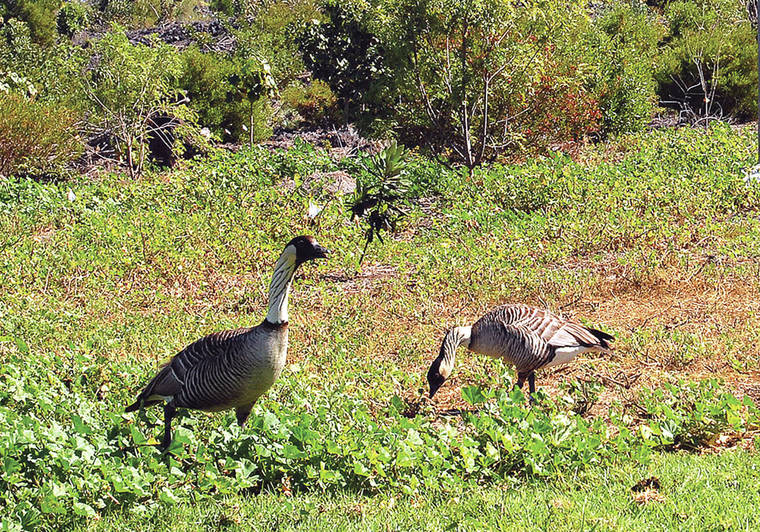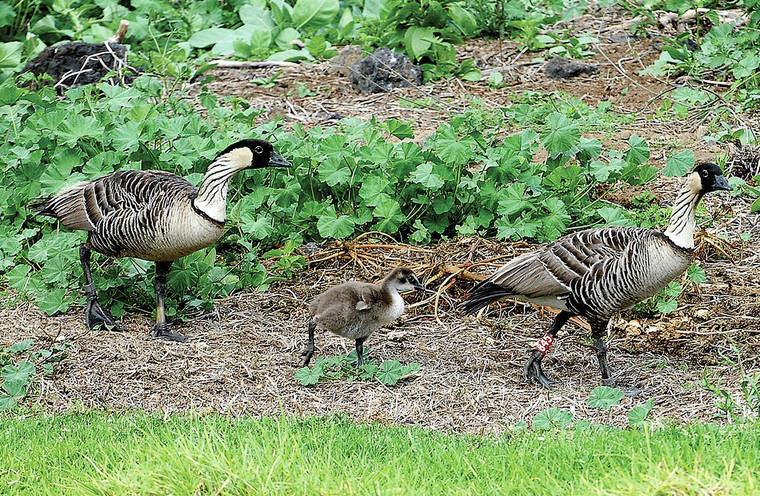KAILUA-KONA — Hawaii’s state bird is no longer on the edge of extinction.
The U.S. Fish and Wildlife Service said the U.S. Secretary of the Interior David Bernhardt will announce today on Oahu the downgrading of the nene, or the Hawaiian goose, from endangered status to threatened.
The U.S. Fish and Wildlife Service credits the new status to a successful captive breeding program, rigorous habitat restoration, and active management strategies as the reason why nene have once again begun to thrive throughout the state.
Nene are Hawaii’s only native goose, and are descended from Canadian geese that arrived on the islands around 500,000 years ago. By 1949, nene had almost became extinct, with only 30 wild nene left throughout the Hawaiian islands.
The population of nene was drastically reduced by introduced predators such as mongooses, cats and dogs; by foraging animals such as cattle, goats and pigs; by hunters; by introduced plants which compete with native food and cover plants; and by loss of lowland habitat.
Jean DeMercer Breese, of North Kohala, whose husband, the late-Paul Breese, was actively involved in the nene conservation effort, said she is “cautiously optimistic” about the new status for the nene.
“I’m concerned and I’m happy that the population has greatly increased,” DeMercer Breese said. “I want people to be educated that we need to protect the nene. I understand that it will make it easier for general populations to approach the nene, but we need to respect their ability to remain wild and the space they do need.”
Breese, the first director of the Honolulu Zoo, started the Nene Restoration Project in 1949.
The project established the first nene rearing facility in the Pohakuloa area on Hawaii Island, which began breeding captive nene from Herbert Shipman’s captive flock. Captive birds were first used in order to not disturb the few remaining wild birds.
Over a 30-year period, 1,699 nene were raised at the facility.
Breese was also vice chairman of the Conservation Council of Hawaii, the commission that pushed to name the nene the official bird of Hawaii. The resolution passed in 1957.
In his book, “The Honolulu Zoo: Waikiki’s Wildlife Treasure 1915-2015” Breese wrote “successfully restoring these formerly exceedingly rare birds into the wild has been a deeply rewarding experience.”
In 2018, U.S. Fish and Wildlife Service began the process to downgrade the nene to threatened after a count of more than 2,800 nene in the state, with 1,095 nene found on Hawaii Island.
Species listed as endangered are species in danger of extinction throughout all or a significant portion of its range. A species listed as threatened means a species that is likely to become endangered within the foreseeable future.
All of the protections of the Federal Endangered Species Act of 1973 are provided to endangered species. Many of those protections also are available to threatened species. The U.S. Fish and Wildlife Service has the authority to determine which protections should apply to each threatened species in order to tailor the protections to best meet the threatened species’ recovery needs.
Even with their news of the population recovery, nene still have a long way to go before their population is fully recovered.
“I really want people to understand that the nene still need to be protected and they still need to be respected,” DeMercer Breese said.


